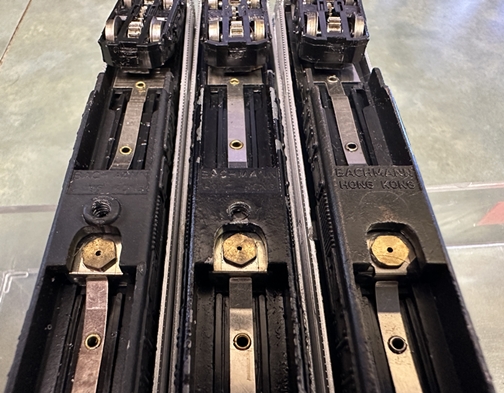

Introduced: 1969
For an old Bachmann design, these are actually pretty decent looking and running models. The shells are nicely painted and detailed and the mechanism is a surprisingly solid performer. All axles are geared and all wheels provide pickup. There are no traction tires. A non-directional headlight is mounted to the front of the chassis. The motor (buried somewhere inside all that metal) is a box-shaped 5-poler. The pantagraph is non-functional (IE, it does not conduct electricity). The chassis weighs a ton, making for a lot of pulling power. Pickup is great and throttle response is exceptionally smooth. Great slow speed creep and a not-too-crazy top-end speed.

My only real complaint with these models is the somewhat insane 1970's Bachmann gearing scheme (metal, metal and more metal, coupled with a scarily complex "cup gear" driveshaft). As a consequence, these things are crazy loud at pretty much any speed.


Like Bachmann's Turbo Train (their other circa-1970 "themed" trainset model), these Metroliners had a relatively short lifespan. I don't know exactly when they were discontinued, but they certainly didn't last into the 1980s when Bachmann started updating their trainset locomotives with split-frame chasses, etc. The chassis pictured above is essentially the only one ever produced for this model.
These models were sold either ala-carte (powered or dummy) or as part of a four car trainset (with three of the cars being dummies). The only livery schemes were Penn Central and Amtrak (and with PC apparently being the most common).



Variations -
Early versions used screws to hold the models firmly inside of their boxes. The holes for said screws changed slighty over the years (eventually being 86'd entirely in the final release) -

The earliest versions had semi-rigid (IE, non-adjustable) pantagraphs. Later runs came with adjustable pantagraphs, EG -

Some early PC units have black stripes instead of red. It is supposed that these were pre-production samples and are thus quite rare -
Some early units had their lightbulbs soldered directly to the motor contacts, whereas later versions used U-shaped connectors that slipped in next to the motor.
Early PC units had the words "Metro Club" printed near each door, whereas later versions did not.
Amtrak and PC shells are not 100% identical. The Amtrak roof is smooth at the cab end to simulate fiberglass, whereas the PC roof is ridged right to the front edge. The Amtrak headlight is flush to the cab front, whereas the PC headlight protrudes from the cab front. Lastly, the PC version has a window opposite the engineer's window, whereas the Amtrak version does not.

(Kudos to contributor Steven Altamura for providing the above info)
Trivia - These same models were also distributed by Tomy in the 1970s (probably only in Japan). Same basic packaging, but with the Tomy name added. EG -

Grade: B (if you can get past all the noise)
Reviewed: 9/70 Model Railroader ("The Bachmann N scale model is ready to run, painted and lettered Penn Central. The one-piece cast plastic body very closely follows the scale dimensions and proportions of the prototype, including its interesting curve-side construction. The model is a few scale inches wider than the prototype. This is not noticeable. The model represents the 76-passenger coach. A fixed Faiveley pantograph comes mounted on each car. It is plastic and not flexible, so it cannot be wired for current pickup. Clear blue-tinted plastic is used for windows in a very effective manner. The power car has an illuminated headlight. The dummy cars have a cast plastic floor and underframe with a sheet metal ballast weight. The trucks are one-piece plastic castings. The scale 44"-diameter metal wheels - the prototype has 36" wheels - have flanges .028" deep. The check gauge is .308". All wheels are insulated. The motor car has a cast zinc alloy frame. A small 5-pole 12 volt motor drives all eight wheels... There are plastic internal gear reductions next to the motor and a worm-and-gear reduction at each truck. The Rapido-type automatic couplers are truck-mounted, which couples the cars about scale 6 feet apart... Our test sample... had a high starting speed. The unit ran smoothly. It tended to be noisy; the application of lubricant reduced this. The motor car should pull five to seven trailers over the average layout... The power car, #4760, is priced $10.98. Unpowered cars, #4770, are $3.98. The cars are also available in train set form: a power car, three trailer cars, a lap of track, power pack, connecting wires, and rerailer, for $29.85")